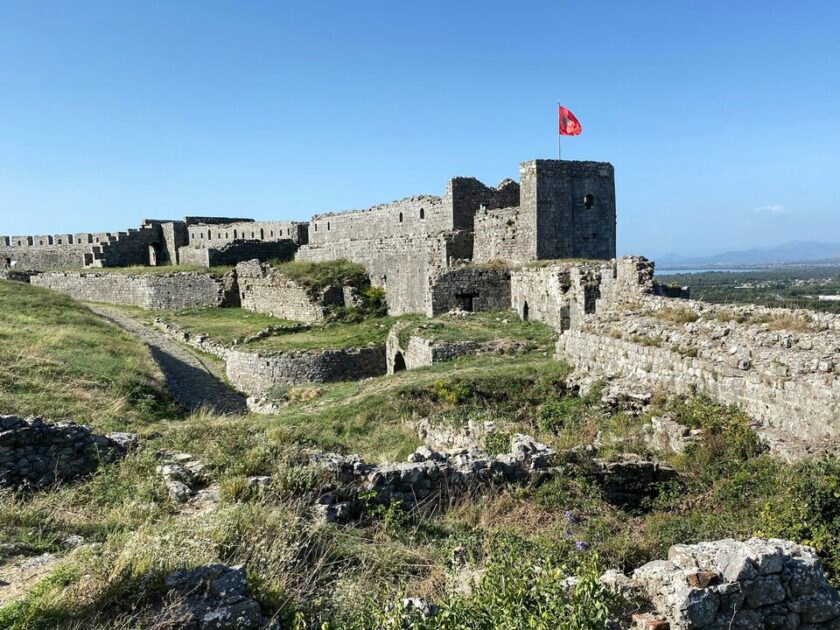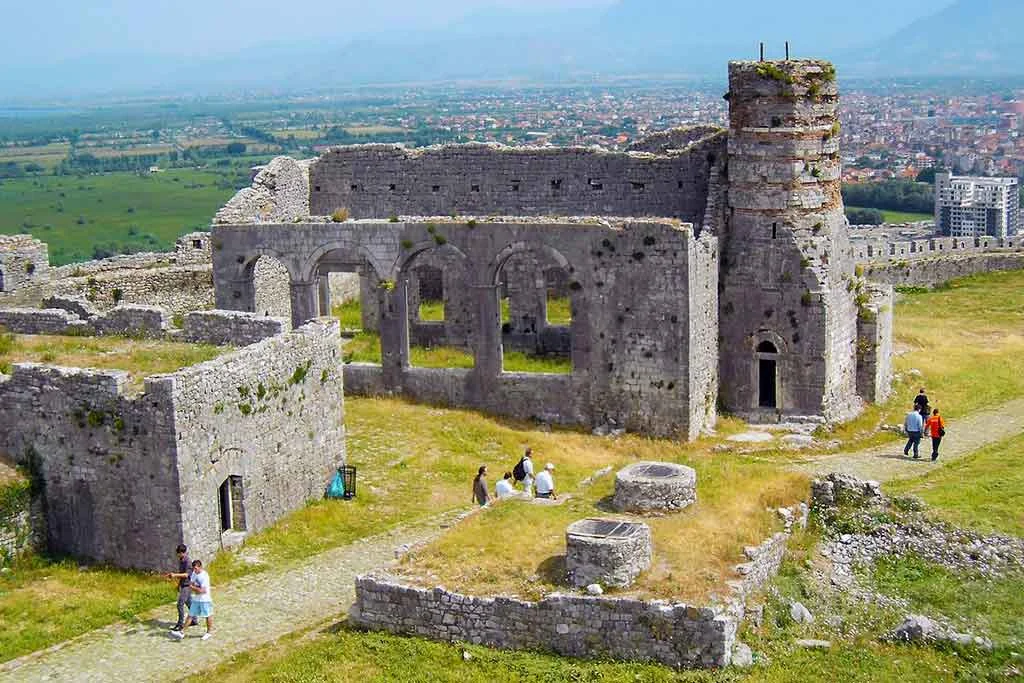
Key Takeaways
- Rozafa Castle is a powerful symbol of Albania’s resilience, history, and culture.
- The castle’s origins date back to the Illyrian period, with layers of influence from Roman, Byzantine, Venetian, and Ottoman eras.
- The legendary story of Rozafa embodies themes of sacrifice, loyalty, and maternal love, deeply rooted in Albanian folklore.
- The architecture features impressive walls, a Venetian tower, a church-mosque, and ancient military structures, showcasing diverse cultural influences.
- Strategically located overlooking Lake Shkodra, the site offers stunning panoramic views and historical significance.
Table of contents
Nestled on a scenic hillside overlooking the historic city of Shkodër, Rozafa Castle is more than just an ancient fortress; it’s a living testament to Albania’s rich history, legends, and resilience. Its stones whisper stories of bygone eras, legendary sacrifices, and enduring cultural pride.
Historical Background of Rozafa Castle
The origins of Rozafa Castle trace back to the Illyrian tribes, who built it as a strategic stronghold to control vital trade routes and protect against invasions. Over the centuries, the fortress has witnessed shifting empires and cultural influences.
Key Historical Periods
From its Illyrian roots to its role in modern Albania, Rozafa’s story is one of resilience and adaptation.
- Illyrian Period (Pre-Roman): The earliest construction was driven by necessity, with tribes fortifying the hilltop for defense and controlling vital routes.
- Roman and Byzantine Periods: The Romans expanded and fortified the castle, which continued to serve strategic military purposes during the Byzantine era.
- Venetian Control (1396-1479): The Venetians recognized its strategic importance, upgrading and fortifying it further.
- Ottoman Period (1479-1912): After a fierce siege, the Ottomans captured and adapted the castle for their administration. Its strategic value kept it vital until Albania’s independence.
- 20th Century: The castle played roles during the World Wars. Restoration initiatives have since preserved its grandeur for future generations.
Notable Events and Figures
- Venetian-Ottoman Wars: The siege and eventual Ottoman conquest marked a turning point, reflecting resilience and shifting allegiances.
- Constantine Balšić: The noble figure who defended Rozafa during Ottoman sieges, symbolizing local resistance.
- Albanian National Awakening: The castle became a symbol of independence and national pride in the late 19th and early 20th centuries.
The Legend of Rozafa
Deeply woven into Albanian folklore, the legend of Rozafa is a poignant story of sacrifice, loyalty, and maternal love. It has become an integral part of the cultural identity associated with Rozafa Castle.
Narrative of Rozafa
The story tells of three brothers tasked with building the castle walls. Every night, the walls would collapse. A wise elder advised that a sacrifice was necessary — a woman must be immured within the walls to ensure their stability.
The youngest brother’s wife, Rozafa, volunteered to be sacrificed. Before she was sealed within, she made a final request: a small opening so she could care for her infant son. This act of love and sacrifice imbues the legend with deep emotional power.
Cultural and Folkloric Significance
The legend highlights themes of loyalty, sacrifice, and maternal affection. The “weeping wall,” said to absorb Rozafa’s tears, symbolizes her enduring love and strength. This story is a moral compass in Albanian culture, teaching values of sacrifice for the greater good.
This tale elevates Rozafa Castle from mere stones into a symbol of national resilience and maternal devotion—an everlasting emblem woven into the fabric of Albania’s cultural heritage.
Architectural Features and Structure
Rozafa Castle showcases a complex blend of architectural styles accumulated over centuries. Its strategic design served both defense and administrative functions, reflecting various cultural influences.
The Layout and Walls
The castle is divided into upper, middle, and lower sections, each offering unique features. Its walls were built from local stone, following the natural contours of the hill. These fortifications protected against invaders and natural elements, showing innovative defensive strategies.
Key Architectural Elements
- Venetian Tower: Offers panoramic views and served as a strategic lookout.
- Church-Mosque: A symbol of religious and cultural shifts, originally a church, later converted to a mosque.
- Arsenal: Used for storing military equipment, emphasizing its strategic role.
- Water Cisterns: Essential for surviving sieges, these underground reservoirs highlight logistical planning. Learn more about medieval defenses.
- Venetian Administrative Buildings: Ruins that reflect the administrative functions during Venetian rule.
Preservation and Restoration Efforts
Ongoing projects aim to stabilize and conserve the site. These efforts ensure the castle’s longevity, allowing future generations to explore its history firsthand. International organizations collaborate with local authorities to restore and protect the architectural integrity of Rozafa.
Rozafa Castle’s Location in Shkodër
Perched atop a hillside overlooking the city of Shkodër, Rozafa Castle’s geographic position was crucial for defense and control during ancient times. Its vantage point provides breathtaking views of Lake Shkodra and the surrounding landscape.
Geographic Placement and Natural Views
The castle overlooks the confluence of the Drin, Buna, and Kir rivers, making it a natural watchtower over trade and water routes. The elevated position affords spectacular vistas of Lake Shkodra, the Alps, and fertile plains, captivating visitors with both history and scenery.
Surrounding Natural Beauty
From its heights, visitors can admire the expansive lake and lush mountains. The natural setting enriches the visiting experience, blending history with scenic tranquility, making Rozafa not just a fortress but a viewpoint of stunning landscapes.
Accessibility and Nearby Attractions
Only a short drive from the city center, Rozafa Castle is accessible by car or taxi. The site offers clear pathways for visitors, with nearby attractions like the Mesi Bridge adding to the cultural itinerary. It’s an ideal day-trip destination for travelers exploring Shkodër.
Visiting Rozafa Castle Today
Today, Rozafa Castle remains a must-visit site that combines history, culture, and breathtaking views. Visitors are invited to step back in time and experience the enduring spirit of Albania’s heritage.
Practical Information for Visitors
- Opening Hours: Open year-round; check local sources for seasonal timings.
- Entrance Fees: Small entry fee supports preservation; details available locally.
- Best Visiting Seasons: Spring and autumn offer ideal weather and fewer crowds.
Travel Tips and Local Amenities
- Accommodations: Shkodër offers hotels, guesthouses, and Airbnb options.
- Dining: Sample traditional Albanian dishes at local restaurants near the castle.
- Transportation: Taxis and buses facilitate easy access to the site.
- Visiting Tips: Wear comfortable walking shoes and bring water during warmer months.
Cultural Significance and Events
Rozafa Castle remains a vibrant cultural hub, hosting festivals, concerts, and exhibitions that celebrate Albanian heritage. These events foster community pride and attract tourists from around the world.
Cultural Events and Festivals
During summer, the castle hosts concerts, dance shows, and folk festivals showcasing traditional Albanian music and dance. These events revitalize the site, bringing history alive in a festive atmosphere.
Fostering Local Identity and Tourism
Rozafa acts as a symbol of national pride and resilience. Its cultural programs help preserve local traditions and attract international tourists, boosting the regional economy and fostering a sense of shared heritage.
Conclusion
Rozafa Castle stands as a monument of Albania’s rich history, legendary tales, and cultural vitality. Its stones echo stories of legendary sacrifice, resilience, and national pride, inviting every visitor to connect with its profound legacy.
Embarking on a journey to Rozafa Castle is more than sightseeing; it’s about immersing oneself in the enduring spirit of Albania, a land of tales, history, and resilience that continues to inspire.


0 Comment